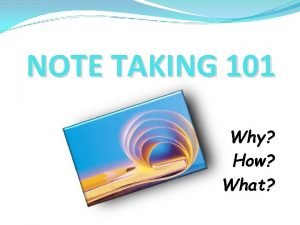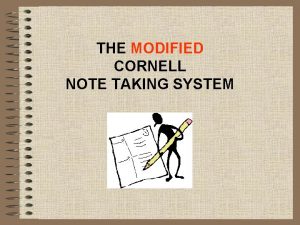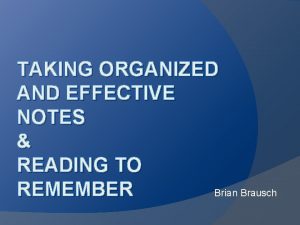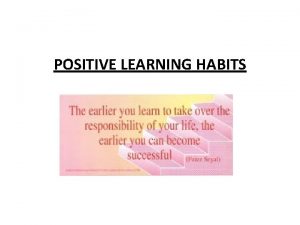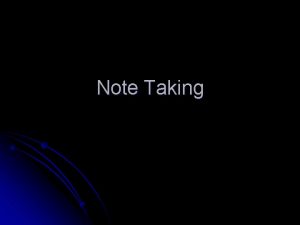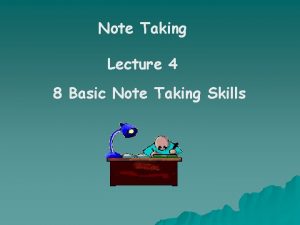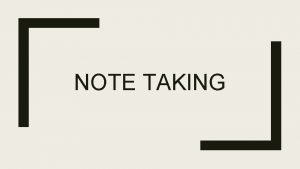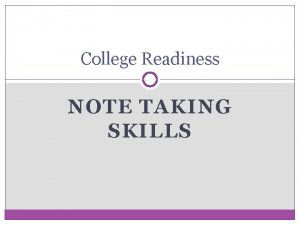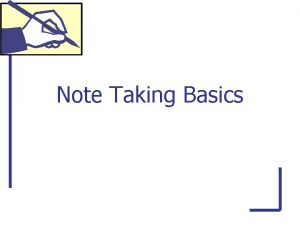ENGLISH I Note taking 101 Listen actively if











- Slides: 11

ENGLISH I Note taking 101

• Listen actively - if possible think before you write - but don't get behind. Be open minded about points you disagree on. Don't let arguing interfere with your notetaking. • Raise questions if appropriate. If you don’t know, ask. • Take and keep notes in a large notebook. The only merit to a small notebook is ease of carrying and that is not your main objective. A large notebook allows you to adequately indent and use an outline form. Leave a few spaces blank as you move from one point to the next so that you can fill in additional points later if necessary. Your objective is to take helpful notes, not to save paper. • Do not try to take down everything that the lecturer says. It is impossible in the first place and unnecessary in the second place because not everything is of equal importance. Spend more time listening and attempt to take down the main points. If you are writing as fast as you can, you cannot be as discriminating a listener. There may be some times, however, when it is more important to write than to think.

• Listen for cues as to important points, transition from one point to the next, repetition of points for emphasis, changes in voice inflections, enumeration of a series of points, etc. • Many lecturers attempt to present a few major points and several minor points in a lecture. The rest is explanatory material and samples. Try to see the main points and do not get lost in a barrage of minor points which do not seem related to each other. The relationship is there if you will listen for it. Be alert to cues about what the teacher thinks is important. Make your original notes legible enough for your own reading, but use abbreviations of your own invention when possible. The effort required to recopy notes can be better spent in rereading them and thinking about them. Although neatness is a virtue in some respect, it does not necessarily increase your learning. • Copy down everything on the board, regardless. Did you ever stop to think that every blackboard scribble may be a clue to an exam/test item? You may not be able to integrate what is on the board into your lecture notes, but if you copy it, it may serve as a useful clue for you later. If not, what the heck -- you haven't wasted anything. You were in the classroom anyway. Sit as close to the front of the class, there are fewer distractions and it is easier to hear, see and attend to important material. • Get assignments and suggestions precisely - ask questions if you're not sure.

Outlines • Outlines are most useful for material that is presented in a well-organized way and material that moves from main ideas to detail. Try following some of these suggestions for successful outline note taking. Use standard Roman numerals or a free form, indented outline to organize the information in a lecture. • Organize your notes by major points and supporting ideas. This allows you to record and organize at the same time. • Leave spaces between sections or main ideas. • If the instructor returns to a point later, you can add information in the appropriate section.

March 3, 2000 World History The Russian Revolution I. Collapse of the Imperial Regime A. WWI a cause of collapse of tsarism 1. 2. 3. B. War aggravated inherent political weaknesses Government unable to get cooperation of the country in war effort Could not remain in war w/out political changes Wartime problems due to econ. Causes and mismanagement 1. 2. Russia more effectively blockaded than allies Poor organization and transport prevented use of internal resources Rasputin

NOTE TAKING - THE CORNELL SYSTEM • • The Cornell system for taking notes is designed to save time but yet be highly efficient. There is no rewriting or retyping of your notes. It is a "DO IT RIGHT IN THE FIRST PLACE" system. 1. First Step - PREPARATION Use a large, loose-leaf notebook. Use only one side of the paper. (you then can lay your notes out to see the direction of a lecture. ) Draw a vertical line 2 1/2 inches from the left side of you paper. This is the recall column. Notes will be taken to the right of this margin. Later key words or phrases can be written in the recall column. 2. Second Step - DURING THE LECTURE Record notes in paragraph form. Capture general ideas, not illustrative ideas. Skip lines to show end of ideas or thoughts. Using abbreviations will save time. Write legibly. 3. Third Step - AFTER THE LECTURE Read through your notes and make it more legible if necessary. Now use the left column. Jot down ideas or key words which give you the idea of the lecture. (REDUCE) You will have to reread the lecturer's ideas and reflect in your own words. Cover up the right-hand portion of your notes and recite the general ideas and concepts of the lecture. Overlap your notes showing only recall columns and you have your review.


Use symbols, diagrams, or drawings to simplify ideas. Example: draw arrows to show connections between ideas. • • + and > increase < decrease w/ with w/o without = equals i. e. that is & for and B for but X for except etc. Leave out vowels. between =btwn among = amng patient =ptnt

• • • If the instructor writes something on the chalkboard/overhead or repeats an idea then it is usually a key point and you should write it down. Try to use a three-ring binder, it allows for more flexibility in rearranging your notes and any handouts that you may receive. Try to sit towards the front and center of the class where you'll be less distracted and can hear the professor the best and have a good angle on any visual aids that may be shown. Don't rely on someone else's notes, you may not understand everything that they write down and you'll learn the best by taking your own notes. If your instructor talks fast, it may help to bring an audio recorder and record the lecture while taking notes. After the lecture is over you can replay the lecture and fill in any parts that you missed in your notes. Do reading assignments or homework questions before class, it is easier to take notes when you know what the instructor is talking about. Date your notes; add titles and subtitles when you move onto a new topic for easy referencing. Write down any terminology along with the definition that the instructor may present. Make sure that you write legibly, if you can't read them later, they'll be useless. If you have sloppy handwriting it may be wise to type your notes so that they are easier to read. If you missed what the instructor said ask them to repeat it or go to the instructor after class and ask for clarification. If you are in a rush, ask the instructor at the beginning of the next class or try to find the answer from a friend or the text. Compare notes with a classmate to make sure you didn't miss any important points.

Preparing for a test • • • Budget your time, make sure you have sufficient time to study so that you are well prepared for the test. Go to review, pay attention to hints that the instructor may give about the test. Take careful notes and ask questions about items you may be confused about. Ask the instructor to specify the areas that will be emphasized on the test. Make sure you go to the class right before the test; it's another prime time for the instructor to give out more hints or the format of the test. Go over any material from old tests, HW's, sample problems, review material, the textbook, class notes. . . that might be on the test. Eat before a test, having food in your stomach will give you energy and help you focus, but avoid heavy foods which can make you groggy. Don't try to pull an all nighter, get at least 3 hours of sleep before the test. Put the main ideas/information/formulas onto a sheet that can be quickly reviewed many times, this makes it easier to retain the key concepts that will be on the test. Try to show up at least 5 minutes before the test will start. Go to the bathroom before walking into the exam room, you don't want to waste anytime worrying about your bodily needs during the test.

Taking a Test • • • • Bring at least two pens/pencils with good erasers, calculator with enough batteries and any other resources that your instructor allows you to. Bring a watch to the test with you so that you can better pace yourself. Keep a positive attitude throughout the whole test and try to stay relaxed, if you start to feel nervous take a few deep breaths to relax. Keep your eyes on your own paper, you don't want to appear to be cheating and cause unnecessary trouble for yourself. When you first receive your test, do a quick survey of the entire test so that you know how to efficiently budget your time. Do the easiest problems first; don't stay on a problem that you are stuck on especially when time is a factor. Do the problems that have the greatest point values first. Don't rush but pace yourself, read the entire question and look for keywords. Ask the instructor for clarification if you don't understand what they are asking for on the test. Write legibly, if the grader can't read what you wrote they'll most likely mark it wrong. Always read the whole question carefully, don't make assumptions about what the question might be. If you don't know an answer skip it, go on with the rest of the test and come back to it later, maybe on another part of the test there'll be something that will help you out with that question. Don't worry if others finish before you; focus on the test in front of you. When you are finished, if you have time left look over your test, make sure that you have answered all the questions, only change an answer if you misread or misinterpreted the question because the first answer that you put is usually the correct one. Watch out for careless mistakes and proofread your essay and/or short answer questions. Double check to make sure that you put your first and last name on the test.
 Difference between note making and note taking
Difference between note making and note taking Example of signal word
Example of signal word Difference between note making and note taking
Difference between note making and note taking Linear method of note taking
Linear method of note taking Note taking 101
Note taking 101 According to walter pauk, 10 weeks after lecture
According to walter pauk, 10 weeks after lecture Listen to the pouring rain
Listen to the pouring rain Modified cornell notes
Modified cornell notes Outline method of note taking
Outline method of note taking Section 17-3 note taking guide answer key
Section 17-3 note taking guide answer key What are the 5 r's in note-taking?
What are the 5 r's in note-taking? What are the 5 r's of note taking
What are the 5 r's of note taking





